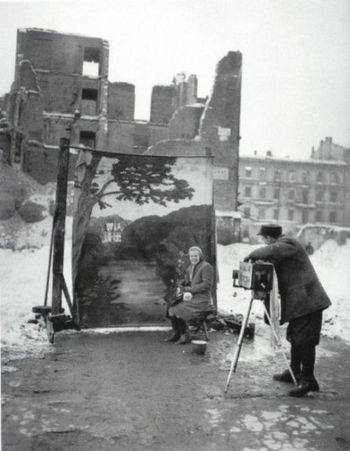I probably shouldn't admit this, because I'm supposed to act like big serious Mr. Expert and all (although I'm not much for pretense and ostentation, as you might know if you've been reading me for a while—cf. the book link at the bottom of this post), but here goes: I actually kind like those jokey collections of cutesy/funny pictures that the Internet is full of. Not the sort of pictures I should be looking at? I guess. But we all look at more kinds of pictures than we can even categorize. It's almost like breathing the air. Lot of chaff in those, of course, but the gems that fall past really are gems.
A photograph at its most basic can tell us something true about the world, or about human beings, or animals, or about something that happened...not "Truth," capital T, but just truths. Little ones.
It's the main thing that separates it from art. It can be more about Observation than Creation. Note caps.
I have a friend who passes these along sometimes. Here's one that made me actually "LOL" (he's all gung-ho about the start of baseball season):
Hilarious. Very human, seems to me. Also very photographic in its essence—not something an artist might think to invent. (Also something you might look at and not even "get" unless you were thinking about it. I think we humans "see mindlessly" the great majority of the time.)
Here's one the same friend also sent me:
He has no idea where it came from. Anybody know anything about it?
This picture strikes me as funny, yes, but poignant as well, and layered—it says a lot about photography, about human concerns with image, in the sense of status and appearances, meta-concerns about truth and falsification, about imagination, about the ideal versus the real, even about hope in the face of despair. It's a wonderful photograph about photography.
I want to know more about it.
Mike
(Thanks to Kim)
UPDATE: It's from the AP, captioned, "A photographer uses his own backdrop to mask Poland's World War II ruins while shooting a portrait in Warsaw in November of 1946. (AP Photo/Michael Nash)." A big thanks to sepp and several others for the information.
Original contents copyright 2013 by Michael C. Johnston and/or the bylined author. All Rights Reserved. Links in this post may be to our affiliates; sales through affiliate links may benefit this site.
A book of interest today:
(To see all the comments, click on the "Comments" link below.)
Featured Comments from:
Kenneth Tanaka: "'...Not something an artist might think to invent.' Exactly. These are scenes that only work as photography. Paintings and drawings might be cute but they would not carry the testimonial value that a photograph carries. Further, one way to measure your progress as a photographer is whether or not you're consistently able to see and capture such moments."
John Wilson: "The camera the photographer is using is interesting. It looks like one of those old street box cameras which used paper negatives and were developed inside the camera. Apparently they are still being used in Afghanistan and Pakistan. There's a very interesting site that goes into some depth about how they are used."
Stan B.: "Apparently, they've reconstructed Old Town Warsaw down to the very last detail—not necessarily as it once was, but as an Italian painter once imagined it to be...."
Mike replies: Good post; good find. I'd like to see it anyway, just for what it is. They don't have this reputation here, so much, but Polish craftsmanship can be amazing.
Chris Lucianu: "After looking at the picture of the photographer using a trompe-everything-backdrop, read the entry on the planned destruction of Warsaw, then look again at the picture. I think it deserves quite a caption.
Likewise, if you look at the page linked to by Stan B., don't just read the brief intro (which I find condensed to almost the point of flippancy). Do yourself a favour and listen to the audio feature untangling the threads of a story as poignant as it is complicated, courtesy of Amy Drozdowska, Michał Murawski and Dave McGuire. Or, taking a somewhat less post-modern view, read art historian Małgorzata Omilanowska's Views of Warsaw by Bernardo Bellotto Called Canaletto and their Role in the Reconstruction of Warsaw's Monuments. Vana Tallinn (2010), if you can obtain it (and kudos if you do).
It becomes clear that the post-war reconstruction team led by Jan Zachwatowicz aimed at re-creating the aspect of an ideal late-Baroque Warsaw (with its Gothic and Renaissance heritage) as it would have existed at the time of Stanisław August Poniatowski, the last Polish king. Bernardo Bellotto's alleged 'imagination' can hardly be faulted. On the contrary, Bellotto was an astonishingly accurate painter of urban landscapes, who used a camera obscura to draw minute documentary sketches which were then integrated into a grand veduta. (Perhaps it is a good opportunity to remind ourselves of the synthetic aspect of painting as opposed to snapshots.)
I spent some time last year studying Bellotto in Dresden, the other center of the painter's activity; and also a city victim of the war, although, unlike Warsaw, a a more haphazard victim. It takes some time to realise that Bellotto was a painter of the social fabric as well as of architecture. The passing of time would have sufficed to transform the buildings he minutely documented into as much a trompe-l'esprit as the Warsaw photographer's canvas. But now, with his paintings more 'original' than the very cityscapes they depicted, we might as well be painting on a mirror.
Andrew Molitor: "I actually wrote a little thing about the 'meme' thing, where you take a picture and apply a caption and get that pseudo-motivational poster.
"It's actually a great lesson in how a caption alters our perception of a photograph. You can take the same photo of some dumb cat, apply 30 captions to it, and create 30 quite different 'experiences of the image.' The captions tend to drive a little imagined narrative to go with the image, and the successful ones drive quite a strong narrative.
"So, they're not just silly funny fun things! They have a little something to teach us about art and the human brain!"





